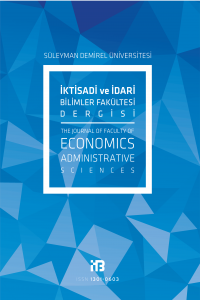AVRUPA ENTEGRASYON TEORİLERİ ÜZERİNE BİR TARTIŞMA: LİBERAL HÜKÜMETLERARASICILIK NE ÖLÇÜDE AÇIKLAYICI?
AB, Avrupa Entegrasyon Teorileri, Liberal Intergovernmentalism
A Discussion On The Theories Of European Integration: Does Liberal Intergovernmentalism Offer A Satisfactory Answer?
-,
___
- BULMER, S: J. (1993). “The Governance of the European Union: A New Institutionalist Approach”, Journal of Public Policy, 13 (4), 351-380.
- CAPORASO, J. A. (1998). “Regional Integration Theory: Understanding Our Past and Anticipating Our Future”, Journal of European Public Policy: 5 (1), 1-16
- CAPORASO, J. A. (1999). “Toward a Normal Science of Regional Integration”, Journal of European Public Policy, 6 (1): 160-164.
- CINI, M. (2007). European Union Politics, New York, Oxford University Press.
- FORSTER, A. (1998). “Britain and the Negotiation of the Maastricht Treaty: A Critique of Liberal Intergovernmentalism”, Journal of Common Market Studies, 36 (3): 347- 368.
- GARRETT, G. AND TSEBELİS, G. (1996). “An Institutional Critique of Intergovernmentalism”, International Organization, 50 (2): 269-299.
- HIX, S. (2005). The Political System of the European Union, Palgrave Macmillan, New York.
- HOOGHE, M. AND MARKS, G. (1996). “’Europe with the Regions’: Channels of Regional Representation in the European Union”, The Journal of Federalism, 26 (1):73-91.
- LEWIS, J. (1998). “Is the ‘Hard Bargaining’ Image of the Council Misleading? The Committee of Permanent Representatives and the Local Elections Directive”, Journal of Common Market Studies, 36 (4): 479-504.
- MORAVCSIK, A. (1993). “Preferences and Power in the European Community: A Liberal Intergovernmentalist Approach”, Journal of Common Market Studies, 3:1 (4):473- 523.
- MORAVCSIK, A. (1995). “Liberal Intergovernmentalism and Integration: A Rejoinder”, Journal of Common Market Studies, 33 (4):611-628.
- MORAVCSIK, A. (1998). The Choice for Europe: Social Purpose and State Power from Messina to Maastricht, UCL Press, London.
- MORAVCSIK, A. (1999). “The Choice for Europe: Current Commentary and Future Research: a Response to James Caporaso, Fritz Scharpf, and Helen Wallace”, Journal of European Public Policy, 6 (1): 168-179.
- PETERSON, J. (2001). “the Choice for EU Theorists: Establishing a Common Framework for Analysis”, European Journal of Political Research, 39: 289–318.
- PIERSON, P. (1996). “The Path to European Integration: A Historical Institutionalist Analysis”, Comparative Political Studies 1996; 29: 123-163.
- POLLACK, M. A. (1997). “Delegation, Agency, and Agenda Setting in the European Community”, International Organization, 51 (1): 99-134.
- POLLACK, M. A. (2001). “International Relations Theory and European Integration”, Journal of Common Market Studies, 39 (2): 221-244.
- PUCHALA, D. J. (1971). “Of Blind Men, Elephants and International Integration”, Journal of Common Market Studies, 10 (3) 267-284.
- RISSE-KAPPEN, T. (1996). “Exploring the Nature of the Beast: International Relations Theory and Comparative Policy Analysis Meet the European Union”, Journal of Common Market Studies, 34 (1): 53-80.
- ROSAMOND, B. (2000). Theories of European Integration, Palgrave, New York.
- SANDHOLTZ, W. AND SWEET, A. S. (1997). “European Integration and Supranational Governance” Journal of European Public Policy, 4 (3): 297-317.
- SCHARPF, F. W. (1999). “Selecting Cases and Testing Hypotheses”, Journal of European Public Policy, 6 (1): 164-168.
- WALLACE, H. (1999). “Piecing the Integration Jigsaw Together”, Journal of European Public Policy, 6 (1), Review Section: 155-160.
- WINCOTT, D. (1995). “Institutional Interaction and European Integration: Towards an Everyday Critique of Liberal Intergovernmentalism”, Journal of Common Market Studies, 33 (4): 597-609.
- ISSN: 1301-0603
- Yayın Aralığı: Yılda 3 Sayı
- Başlangıç: 1996
- Yayıncı: Süleyman Demirel Üniversitesi
Öğr.Gör.Veysel DAL, Yrd.Doç.Dr.Ahmet Hüsrev EROĞLU
BELEDİYELERDE DIŞ MALİ KAYNAK KULLANIMI: BÜYÜKŞEHİR BELEDİYELERİ ÜZERİNE BİR İNCELEME
Öğr.Gör.Onur DURUKAL, Doç.Dr.F.Neval GENÇ
TÜRKİYE’DE İL ÖZEL İDARESİ SİSTEMİNİN DÖNÜŞÜMÜ VE 6360 SAYILI KANUNUN DÖNÜŞÜME ETKİLERİ
Öğr.Gör.İbrahim GUNDAK, Yrd.Doç.Dr. Hakan ÇETİN
KAYITDIŞI EKONOMİYİ ÖNLEMEYE YÖNELİK BİR ÖNERİ: VERGİ DENETİM ÜST KURULU
Yrd.Doç.Dr.Burcu GEDİZ ORAL, Arş.Gör.Tuğba ARPAZLI FAZLILAR, Yrd.Doç.Dr.Özgür Emre KOÇ
TÜRK İMALAT SANAYİSİNDE FİRMA DÜZEYİNDE YENİLİĞİN BELİRLEYİCİLERİ ÜZERİNE BİR ARAŞTIRMA
Arş.Gör.Dr.Buhari DOĞAN, Prof.Dr.Mesut ALBENİ
ÜLKELERİN FİNANSAL GELİŞMİŞLİKLERİ İLE ENERJİ TÜKETİMLERİ ARASINDAKİ İLİŞKİ: DÖRT KITA ÖRNEĞİ
yrd.doç.dr.fatih Burak GÜMÜŞ, Arş.Gör.Mustafa KOÇ
KAZANÇ AÇIKLAMALARININ ŞİRKET DEĞERİ ÜZERİNDEKİ ETKİLERİ: BİST 100 ÜZERİNE BİR UYGULAMA
